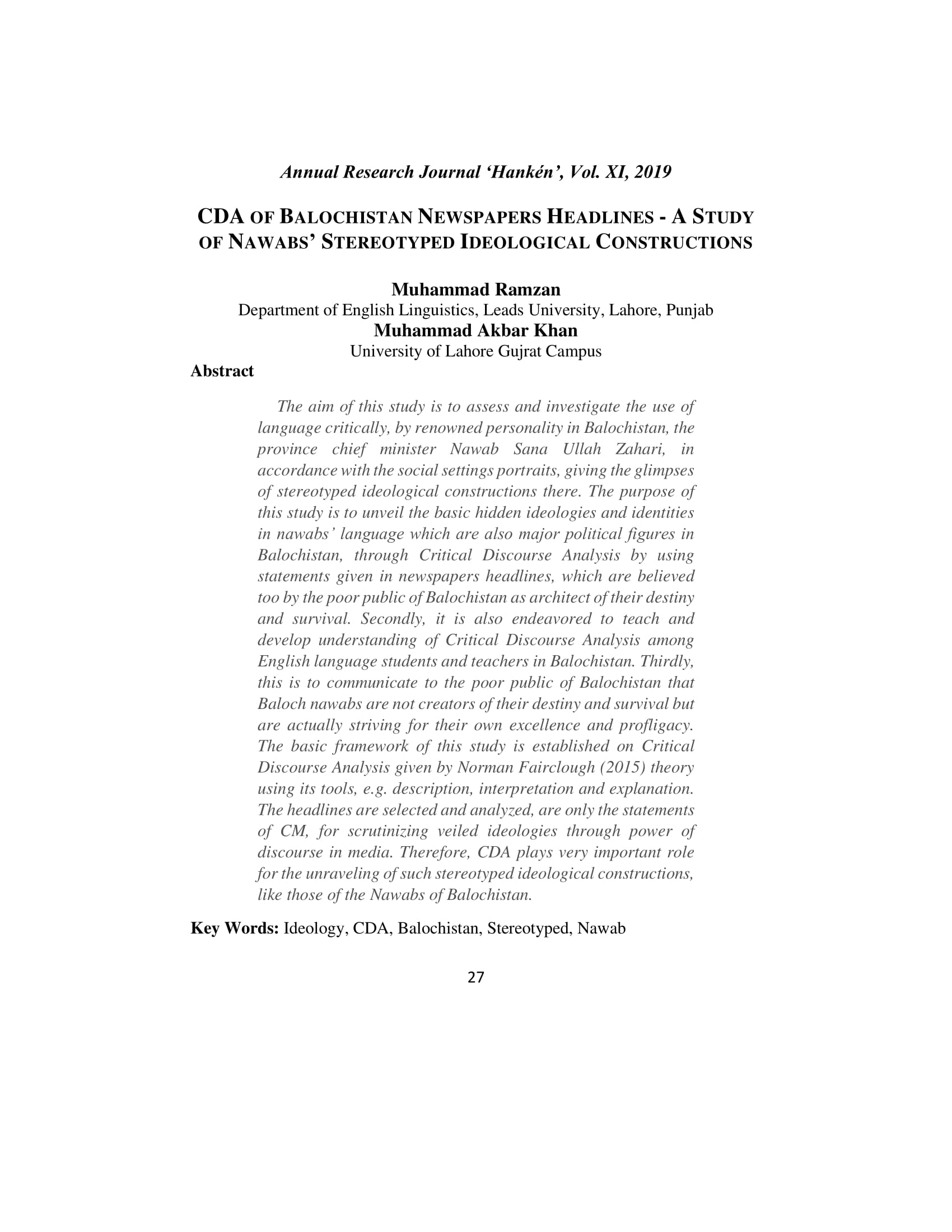CDA OF BALOCHISTAN NEWSPAPERS HEADLINES - A STUDY OF NAWABS’ STEREOTYPED IDEOLOGICAL CONSTRUCTIONS
Abstract
he aim of this study is to assess and investigate the use of
language critically, by renowned personality in Balochistan, the
province chief minister Nawab Sana Ullah Zahari, in
accordance with the social settings portraits, giving the glimpses
of stereotyped ideological constructions there. The purpose of
this study is to unveil the basic hidden ideologies and identities
in nawabs’ language which are also major political figures in
Balochistan, through Critical Discourse Analysis by using
statements given in newspapers headlines, which are believed
too by the poor public of Balochistan as architect of their destiny
and survival. Secondly, it is also endeavored to teach and
develop understanding of Critical Discourse Analysis among
English language students and teachers in Balochistan. Thirdly,
this is to communicate to the poor public of Balochistan that
Baloch nawabs are not creators of their destiny and survival but
are actually striving for their own excellence and profligacy.
The basic framework of this study is established on Critical
Discourse Analysis given by Norman Fairclough (2015) theory
using its tools, e.g. description, interpretation and explanation.
The headlines are selected and analyzed, are only the statements
of CM, for scrutinizing veiled ideologies through power of
discourse in media. Therefore, CDA plays very important role
for the unraveling of such stereotyped ideological constructions,
like those of the Nawabs of Balochistan
References
Al-Faki, Ibrahim Mohamed. 2014. Political Speeches of Some African Leaders from
Linguistics Perspective (1981-2013).
Carter, R., & Simpson, P. (1989) Language, discourse and literature: An
introductory reader in discourse stylistics.London: Unwin Hyman Ltd.
Eagleton, . (1991) Ideology: An introduction. London: Verso.
FAIRCLOUGH, N. 1989. Language and Power, London: Longman.
________________ 1992. Discourse and Social Change, London: Polity Press.
________________1995. Critical Discourse Analysis, London: Longman.
________________ (1997). Critical discourse analysis In T. van Dijk (Ed.),
Discourse as social interaction(pp. 258–84). London: Sage.
Fiske, J. (1994). Media matters: Everyday culture and political change.
Minneapolis: University O Minnesota Press.
Hodge, B., Kress, G. and Jones, G. 1979. The ideology of middle management. In
R. Fowler et al. pp. 81-93.
Habermas, J. (1979). Communication and the Evolution of Society. Boston:
Beacon.
Mahboob, A. & Paltridge, B (2013). Critical Discourse Analysis and Critical
Applied Linguistics. The encyclopedia of applied linguistics. UK: Wiley Blackwell.
General Pervaiz Musharaf (2000) Public Adress 14August the Independence Day
Jackson, Richard. 2014. Language Power and Politics: Critical Discourse Analysis
and the War of Terrorism.
Kundi, M.A. (2008). The tribal set up and elections in Balochistan. In Hasnat, F.S
& Faruqui, A. (eds.). Pakistan: unresolved issues of state and society. Vanguard
Publications
Simpson, P. (1993). Language, ideology and point of view. London: Routledge.
Van Dijk,Teun A,1995, Aims of Critical Discourse Analysis
van Dijk, T. A. (1993, April). Principles of critical discourse analysis. Discourse &
Society, 4(2), 249-283.
van Dijk, T. A. (1998a). Ideology: A multidisciplinary approach. London: Sage.
van Dijk, T.A. (1998b). Towards a theory of context and experience models in
discourse processing. In H. Van
Oostendorp & S. Goldman (Eds.), The construction of mental models during
reading. Hillsdale, NJ: Erlbaum.
van Dijk, T. A. (2002). Political discourse and political cognition. Politics as Text
and Talk: Analytic Approaches to Political Discourse, 203.
van Dijk, T. A. (2006, May). Discourse and manipulation. Discourse & Society,
(3), 359-383.
Wang, H. C. (2009). Language and ideology: gender stereotypes of female and male
artists in Taiwanese tabloids. Discourse & Society, 20.6, 747-774.
Wang, Junling. 2010. A Critical Discourse Analysis of Barack Obama’s Speeches.
Wodak, R. (2008). Introduction: discourse studies - important concepts and terms.
In R. Wodak & M. Krzyzanowski, Qualitative discourse analysis in the Social
Sciences. Palgrave, Basingstoke.
Wodak, R., & Meyer, M. (Eds.). (2009). Methods for critical discourse analysis (2nd
ed.). London: Sage.
Wodak, R. (1989). Language, power and ideology. John Benjamins Publishing
Company, Amsterdam, Philadelphia.
Wodak, R., and M. Meyer.(2001).Methods of critical discourse analysis. Great
Britain: SAGE Publications.
Wodak, R., and R. Cilla.(2006). Politics and Language: Overview, 707-719. In
Brown, K. (ed.) Encyclopedia of Language and Linguistics (Second
Edition).Elsevirer, Ltd.


